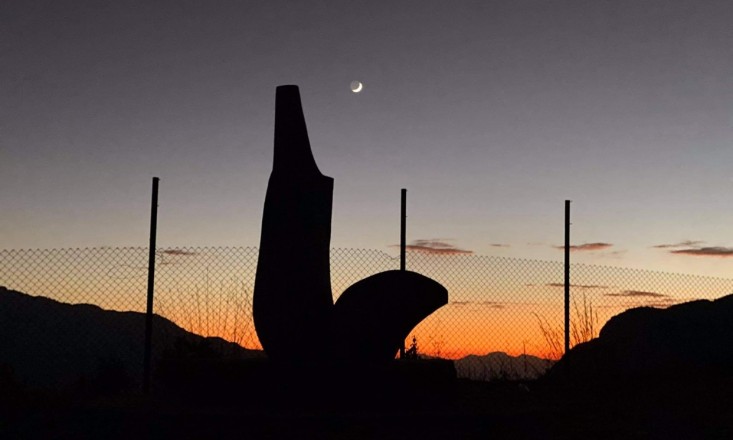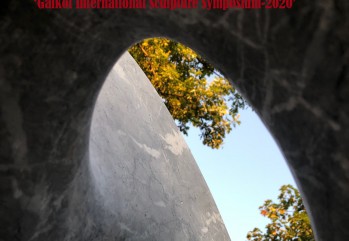Art in nature: Shifting trends in Nepali sculpture
 2022, Sep 15
2022, Sep 15
Art in nature: Shifting trends in Nepali sculpture
Art in nature: Shifting trends in Nepali sculpture
Om Khattri
Abstract:
Art has its environment and meaning, and it can exist free from a pedestal. Different approaches have sprung up with current environmental impacts, including other outdoor sculptures in Nepal as a modern movement. This activity has given new meaning to local indigenous values, art, and crafts. The transition started after some naturalistic sculptures, including equestrian statues, were brought from Europe and installed in the open environment. Environmental sculpture is public art that creates or changes the spectators' surroundings. Nepalese sculptors have practiced a new genre as an alternative discipline of sculpture. A significant sculpture, Nirmāna, which means construction, was created by Thakur Prasad Mainali in 2024-25 B.S. at Bhirkutimandap, Kathmandu. Hence, two methodological approaches-primary, observation, and historical connections used to conduct this study. Besides numerous modern sculptures, this investigation focused on the earliest environmental sculptures. The study also explores the historical significance of sculpture in Nepal as it evolved and assimilated into modernity over time. After centuries of artistic and cultural legacy in Nepal, environmental sculpture underwent new changes.
Keywords: environmental, naturalism, modernity, monumental, architectonic
1. Introduction:
Environmental sculptures share a characteristic that distinguishes them from art history. While it also evoked the most intimate correlations between nature and art, it creates shadows and tints the illumination near a spot. This kind of sculpture is public art that alters or creates exciting surroundings for the viewer. Environmental art began in the mid-1960s and has continued to the present day (Carlson, 2005). The environmental sculptures use new theories, materials, and processes. The trend has evolved toward site-specific and artistic expression, just as in the west. Notable sculptors are Tony Smith, George Segal, and Robert Smithson in the west; D.P. Roy Chaudhay, Ramkinker Baij, Sankho Chaudhary in India, and similarly, Thakur Prasad Mainali, Pramila Giri, and many more in Nepal.
This paper has explored Nepali sculpture tradition changes into modernity encountered with the outside world, especially in Europe. The Sugauli Treaty, signed in 1816 between Britain and Nepal, resulted in several significant transformations in Nepali cultural aspects, particularly in determining the country's future art and architecture (Chitrakar, 2021). Previous writing on encounters with the naturalistic approaches of western art, Chitrakar (2012) states that-
British Embassy in Kathmandu, one of the earlier staff members and scholars during 1919-20 was Brain Hodgson. He appointed Rajman Chitrakar, an artist, to illustrate the natural history subjects. Western realistic style has been seen in the Nepali art tradition and the direct instruction by Hodgson (p. 116-17).
Likewise, Prime Minister Junga Bahadur Rana and other officials visited Europe in 1851; Nepali traditional society incorporated western social realist art forms. Nepalese artists also traveled to India for academic instruction. Western art schools had been established in several locations to train artists and skilled workers. Tej Bahadur Chitrakar and Chandra Manshimha Maskey graduated from Calcutta's Government School of Art. Ramananda Joshi and others graduated from the Sir J.J. School of Arts in Bombay (Chitrakar, 2012). Following that, Nepali artists became familiar with new art forms' western techniques and materials.
Studying Nepali modernity in sculpture has concentrated on how Jung Bahadur's European trips significantly impacted the arts of painting, sculpture, and architecture. Seven Equestrian statues and other types of antiquities have been brought from Europe. In the previous article, Khattri (2017) discussed the soldiers' significant statues and other naturalistic sculptures. In 1925 A.D., the Nepali sculptor Ratna Bahadur Tuladhar erected a statue of a Gorkha soldier on top of the monumental Military Hospital. It was the foundation for a new kind of sculpture on native land. The contemporary social life of the people is depicted on the base of Chandra Shumsher Rana's horse-riding sculpture. These also were carried from Europe, with the same equestrian statue. The eight significant reliefs served as an illustrative narration of the city's development during his reign. In 1945, Ramkinker Baij and Sankho Chaudhary were invited from India to create a soldier's monument in Tundikhel (military parade ground) in Kathmandu.
Sculptors in Nepal have received training from the ground up, much like painters. Thakur Prasad Mainali and Pramila Giri gained rigorous academic tutelage in western modern art in different art institutions in India. Govinda Narayan Jyapoo, Sushma Shimkhada, Praveen Kumar Shrestha, and others were famous sculptors during the shift. After getting western education, Nepali sculptors have begun to display their work in Nepal and in international exhibitions. This step has contributed to the modernity of Nepali sculpture. An artist erupts from beneath the roof and leads to the open air. Hence, another significant environmental sculpture marks the transition. Thakur Prasad Mainali created the architectonic sculpture Nirmāna in 2024-25 B.S. As in the relief sculpture of Chandra's equestrian statue, illustrative motifs are shared differently in the sculpture Nirmāna. This sculpture reflects a new tendency in the sculpture trend.
5. Conclusion:
Environmental sculptures generate reflections and color the light in the space around specific sites. These sculptures are public art that creates or changes the spectators' surroundings. Modern Nepali sculpture, like modern Nepali painting, has found its footing in the face of western influences in art and life. Earlier, natural images brought from Europe and a few significant monuments have created native land as well. The ruler's and donors' sculptures had erected the surrounding temples and secular images on struts. Following sculptors such as Thakur Prasad Mainali and other luminaries, who got academic training from Indian art institutions, were familiar with new forms and ideas of modern sculpture.
The colossal environmental sculpture, Nirmāna, was created by Thakur Prasad Mainali in 2024-25 B.S. The sculpture forms seem to juxtapose cylindrical figures and cuboids into shapes that lyrically develop in space. The sculptor built the structure using the cement-concrete medium, which has modified the constructive process of the materials' truth and its massive scale. He made the entire structure like a Nepalese Shikhar temple architecture or Rath (chariot) that constantly pinnacled higher than the mountain peak.
Cultural motifs do not just intrinsically relate to their environments. It is also impossible to define it without them. The environmental sculpture has demonstrated the subject matter, new styles, and significant modifications in the sculptor's perspectives on Nirmāna's structure. It demonstrated sophistication when modern Nepal emerged. In contemporary art genres, incorporating ideas into this sculpture has provoked less debate and criticism. A longstanding tradition in Nepalese culture has paved the way for dramatic transformations in environmental sculpture during the transition.
References
Carlson, A. (2005). AESTHETICS AND THE ENVIRONMENT The appreciation of nature, art, and architecture. In Aesthetics and the Environment: The Appreciation of Nature, Art, and Architecture. Routledge. https://doi.org/10.4324/9780203981405
Chitrakar, M. (2012). Nepali Art issues miscellany. Teba-Chi Studies Center.
Chitrakar, M. (2021). Nepali Art Thoughts &Musings. Sirjana College of Fine Arts.
Finn, D. (1989). How to look at sculpture (B. Fazio (ed.)). Harry N. Abrams, Inc.
Jing, A. (1994). The Portraits of Khubilai Khan and Chabi by Anige (1245-1306), a Nepali Artist at the Yuan Court. Artibus Asiae, 54(1/2), 40–86. https://doi.org/10.2307/3250079
Karki, S. (2010). Those rulers on horses. My Republica The Week.
Khattri, O. (2017). Aadhunik Nepali Murtikala:Sandarbha Aitihasik Sainik Smarak Murtiharu. Sirjana A Jornal on Arts and Art Education, 4(The 16th Anniversary Issue), 98–107.
Kramrisch, S. (1964). The Art of Nepal. The Asiatic society.
Mainali, L. (2061a). Adhunik Nepali Murtikala. Tribhuvan University.
Mainali, L. (2061b). Thakur Prasad Mainali ra Uhanka Adhunik Batabarniya Murtiharu. Mainali Indira.
Minali, L. (2053). Kala ra Kalakar. Sharma, Arjun Prasad & Sharma, Anju.
Parimoo, R. (1975). Studies in Modern Indian Art. Kanak Pupblications.
Read, H. (1964). Modern Sculpture a Concise History (First). Themes & Hudson Ltd.
Slusser, M. S. (1982). Nepal Mandala A Cultural Study of the Kathmandu Valley Volume I. Princeton University Press.
Journal of Fine Arts Campus, 2021 Volume 3 Issue 1 Peer-Reviewed Research Article 35 Open Access Art in nature: Shifting trends in Nepali sculpture Om Khattri1* 1Lecturer in Sculpture at Lalitkala Campus, Tribhuvan University *Corresponding Author: sculptorom@hotmail.com Citation: Khattri, O. (2021). Art in nature: Shifting trends in Nepali sculpture. Journal of Fine Arts Campus, 3(1),








